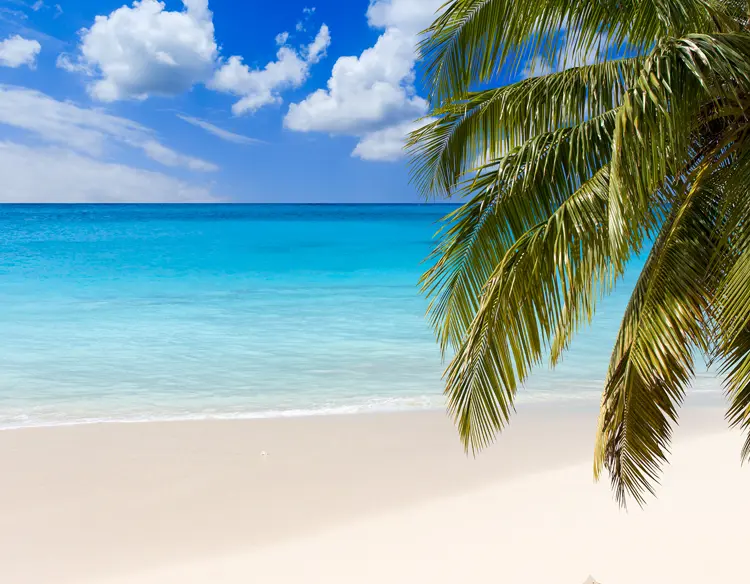Imagine the scene. You're breathing in the clean air through the window of an electric tram on your short, subsidised morning commute from home to the centre of the city. Or perhaps you're cycling on a newly-constructed path, sheltered from the sun by a shady canopy (that also functions as an energy source with its integrated solar panels). For lunch you will enjoy locally-sourced produce, courtesy of your island's thriving agricultural sector, and after work you might take a dip in the sea, marvelling at the healthy coral and sea life protected by one of several newly-created marine reserves.
It all sounds like a distant utopia, but with ambitious vision, cooperation, investment and strong leadership, perhaps it might be closer than we think.
The Caribbean needs huge regional investment in climate resilience, renewable energy, infrastructure, agriculture and conservation of nature if it is to thrive (and, in the case of particularly vulnerable nations, even survive).
So where might this investment come from?
ESG Bonds
The ESG bond market has the potential to play a transformative part in the region's advancement. Given the increasing global appetite for sustainable investment [1], backed by credible commentary that ESG bond sales could grow by 30% in 2023 and rebound to almost the same levels as 2021[2], there are promising prospects for this type of investment in the Caribbean, particularly in the subsets of green bonds and blue bonds.
Green bonds are a type of debt instrument used to finance "green" endeavours such as renewable energy or forestry projects. Blue bonds work on the same principle, but the projects are marine-focused rather than land-focused (for example to finance conservation of marine ecosystems, sustainable fisheries, renewable marine energy and coastal protection). These instruments are gaining traction in our region, with Belize issuing the largest ever sovereign blue bond in 2021 (supported by The Nature Conservancy's Blue Bonds for Ocean Conservation Program).
Barbados followed suit with its own blue bond last year, again supported by The Nature Conservancy.
The Intrinsic Value of Nature
The traditional financing model for these thematic bonds relies on 'use of proceeds', whereby the underlying project generates a financial return, which is then fed up to the investors. But where financial returns are less clear-cut, innovative alternatives to this model, such as a 'debt for nature swap' can be incorporated. This mechanism recognises the intrinsic value in the natural environment and was used by the Government of the Seychelles in 2018 to restructure its national debt.
There are several such examples of sovereign debt being refinanced at a discount, with the resulting savings being used to support conservation work (the Belize structure is one such example). A key point is that nations that are rich in natural resources can use conservation commitments as leverage in financial negotiations.
The Cayman Islands
Which brings us to the Cayman Islands, a nation whose abundant natural resources are often overlooked. Cayman's coral reefs and stingrays attract visitors from all over the world (various outlets have reported that each Caymanian stingray generates about US$500,000 a year in tourism revenue) and Grand Cayman's Central Mangrove Wetland is the largest contiguous mangrove ecosystem in the entire Caribbean. The mangroves are of particular value as they serve as extremely efficient carbon sinks (five times more so than terrestrial rainforests) and could bring investment in the form of blue carbon credits.
As well as being a viable investment prospect, Cayman is the pre-eminent domicile for issuers of this type of debt instrument, due to its established financial services sector and stock exchange, modern and flexible corporate structures, light but effective regulation and tax neutrality - (the issuer in the Belize structure was a Cayman entity).
A Regional Approach
But what if we extended our ambition beyond the individual sovereign states that make up this incredible area of the globe? What if we set our sights on a pan-Caribbean hybrid green/blue bond, aka 'The Caribbean Turquoise Bond'?
The Caribbean is made up of numerous small island developing states, many of which have crippling debt but plentiful natural resources. Opportunities abound in industries such as solar and geothermal energy, sustainable fishing, agriculture and eco-tourism. Keep in mind also the level of educational attainment and innovation amongst the Caribbean population (demonstrated by The University of the West Indies being ranked in the top 1.5% of higher education establishments worldwide for 2022[3]).
With visionaries like Prime Minister Mia Mottley of Barbados making their voices heard on the world stage (exhorting the audience of COP26 to 'try harder' in 2021[4]), the backing of development finance institutions (such as the Caribbean Development Bank), together with the immense wealth of the private sector, the timing has never been better for a huge regional sea-change.
After all, as it says in my son's favourite story book[5], 'Everyone on the island wants clean beaches. Everyone on the island wants clean water. Everyone on the island wants to save the sea life and bring back the whales.'
We owe it to his generation and their descendants to try harder.
[1] In October 2022, PWC projected an 84% increase in ESG-focused institutional investment between 2021 and 2026.
[2] https://www.reuters.com/business/sustainable-business/green-bonds-are-set-drive-corporate-esg-debt-out-slump-2023-barclays-2023-01-04/
[3] https://www.mona.uwi.edu/news/uwi-soars-top-latest-global-universities-rankings
[4] https://youtu.be/PN6THYZ4ngM
[5] Clean Up! By Nathan Bryon and Dapo Adeola



